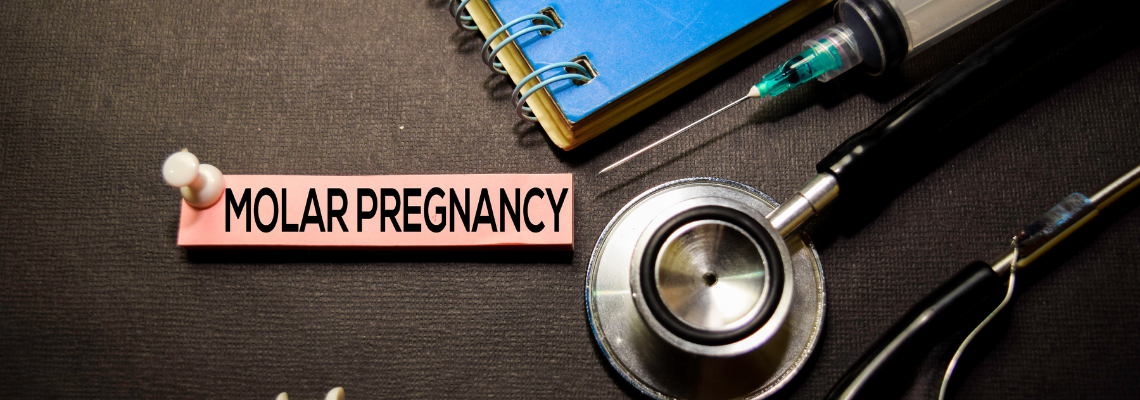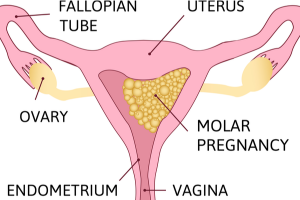
Molar pregnancy is a rare pregnancy complication that can cause serious health problems for the mother and baby. Learn more about it and how to prevent it.
Pregnancy is a time of change and growth for both the mother and child. When a woman becomes pregnant, her body goes through a huge transformation. Pregnant women often experience a wide range of symptoms, some of which are difficult to understand or diagnose. Here we’ll help pregnant women and their families understand these symptoms and more about molar pregnancy.
What Is Molar Pregnancy?
When a sperm and an egg join incorrectly during fertilization and a tumor (non-cancerous) forms instead of the normal placenta, that pregnancy is termed as molar. Molar pregnancy is also referred to as hydatidiform mole, a mole or gestational trophoblastic disorder. This kind of pregnancy does not last since the placenta that supports and nourishes the baby is not in existence. Though rarely, it may also result in health complications for the mother. The tumors forming in the uterus appear as fluid-filled cysts, which resemble grapes.
There are two types of molar pregnancies. One is partial, and the other one is complete. A partial pregnancy is when the embryo and the placenta are abnormal, while a complete pregnancy is when there is no embryo, and the placenta is abnormal. If you experience this complication, do not worry because you can have a successful and healthy pregnancy after that.
Causes
 An abnormality with the fertilized egg causes molar pregnancy. In most cases, both gametes carry 23 chromosomes each. Still, in the case of molar pregnancy, the fertilized egg contains an extra chromosome set, which results in an abnormal gene balance. Hence, the affected follicle cells cannot produce nonvolatile substances like estrogen and progesterone. The cell division is faulty. Because your body did not release the major hormones for the growth of the fetus and placental development, the placenta becomes enormous but with no differentiation.
An abnormality with the fertilized egg causes molar pregnancy. In most cases, both gametes carry 23 chromosomes each. Still, in the case of molar pregnancy, the fertilized egg contains an extra chromosome set, which results in an abnormal gene balance. Hence, the affected follicle cells cannot produce nonvolatile substances like estrogen and progesterone. The cell division is faulty. Because your body did not release the major hormones for the growth of the fetus and placental development, the placenta becomes enormous but with no differentiation.
Symptoms of Molar Pregnancy
Molar pregnancy has several symptoms, which include:
Most patients experience mild cramps and pain in the lower abdomen one or more times during pregnancy. This time is sometimes referred to as the first bleed. Menstruation stops after conception. Sometimes blood-stained menstrual discharge may occur, generally called breakdown bleeding. This pregnancy complication causes minor internal bleeding, which may or may not be accompanied by severe pain and infection like fever, chills, irregular pulse and abnormal heartbeat.
You may also experience nausea and vomiting if you have a molar pregnancy. This symptom may occur at any stage in pregnancy. It usually occurs after a period of continuous bleeding, but it can also last for days or weeks without explanation before this symptom occurs.
Some women with molar pregnancy can experience sciatica with incoordination and foot drop from nerve irritation in the lower extremities. This is more common when fundal pressure symptoms are present, such as lower abdominal pain, constipation and nausea.
Other symptoms include:
- Rapid uterine growth
- Ovarian cysts
- Preeclampsia
- High blood pressure
Risks of Molar Pregnancy
You can treat a molar pregnancy with a surgical procedure called an early pregnancy termination or an induced abortion in which the embryo is killed. This is usually performed when the pregnancy has been diagnosed by a gynecologist and also when there are other risk factors for an adverse outcome. For example, if you have multiple pregnancies or a preexisting condition that is more likely to cause complications during pregnancy, you may have an induced abortion.
If it is not terminated early enough, the pregnancy may result in miscarriage. Molar women are also at risk of premature delivery. If the pregnancy leads to preterm birth, hypoxia and shallow breathing can occur. When this happens, the newborn will require intensive care to survive.
How to Prevent Molar Pregnancy
There are currently no preventative measures for a molar pregnancy. Some doctors suggest that a tumor on an ultrasound will result in an earlier diagnosis. It is vital to know when to see a doctor and how to treat the condition if it should occur to avoid early miscarriage, premature delivery or even death.
If you are experiencing symptoms, contact your doctor immediately to determine your risks and the appropriate treatment for your condition.


